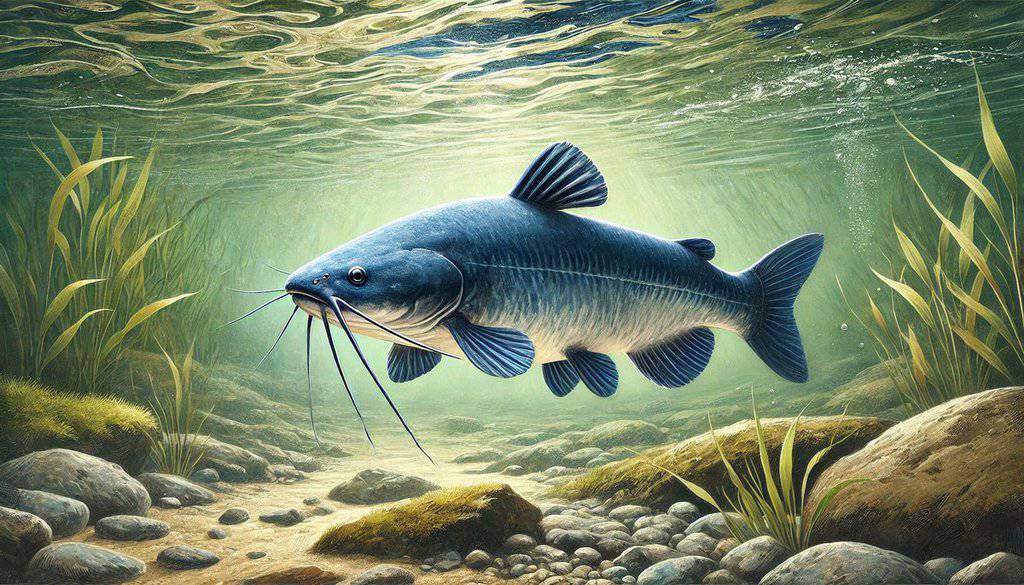Blue Catfish is a popular species for aquaponics due to its rapid growth, adaptability, and excellent food quality. As the largest catfish species in North America, it offers substantial meat yield and is prized for both commercial and recreational fishing[1][2]. Blue catfish are known for their resilience, disease resistance, and ability to thrive in various water conditions, making them an attractive option for aquaponics enthusiasts[1].
Natural Habitat and Behavior
Origin and native environment: Blue catfish are native to major rivers in the Mississippi, Missouri, and Ohio River basins of the central and southern United States, extending south into Mexico and northern Guatemala[3]. They prefer large rivers with deep channels, swift currents, and sandy bottoms[4].
Natural behavior in the wild: Blue catfish are bottom-dwellers and opportunistic predators. They spawn once a year from late May into June, mostly in lower-salinity streams and smaller tributaries[4].
Temperament: In aquaponics systems, blue catfish can be territorial and potentially aggressive, especially as they grow larger.
Compatibility: Due to their size and predatory nature, blue catfish are best kept in single-species systems or with other large, hardy fish.
Water Requirements
Temperature Range:
- Ideal temperature: 21-29°C (70-84°F)
- Temperatures outside this range can stress the fish and affect growth rates.
pH Level:
- Recommended pH range: 6.5-8.5
- Blue catfish are relatively tolerant of pH fluctuations.
Water hardness: Prefer moderate to hard water (100-250 ppm)
Oxygen Levels: Ideal dissolved oxygen: >5 mg/L, are tolerant of low oxygen conditions but thrive in well-oxygenated water[1].
Ammonia/Nitrate Sensitivity: Sensitive to high ammonia and nitrite levels, maintain ammonia below 0.5 ppm and nitrite below 0.1 ppm
Tank or Pond Setup
Tank/Pond Size Requirements:
- Minimum 1,000 liters (264 gallons) per adult fish
- Density: 20-30 kg/m³ (1.25-1.87 lbs/ft³) for optimal growth[1]
Filtration & Aeration:
- Require robust filtration and strong aeration
- High water turnover rate recommended
Lighting Considerations:
- Prefer subdued lighting
- Natural light cycles are beneficial for growth and breeding
Tank Decorations/Substrate:
- Provide hiding spots with large rocks or artificial structures
- Sandy substrate preferred, mimicking their natural habitat
Feeding Requirements
Diet:
- Omnivorous, with a preference for animal protein
- Commercial catfish pellets (32-36% protein) as a staple diet[1]
Feeding Techniques:
- Feed 1-2 times daily
- Adjust feeding rate based on water temperature and fish size
- Use floating pellets to observe feeding behavior
Supplements:
- Occasional live or frozen foods (e.g., worms, insects) can enhance growth and breeding condition
Growth and Reproduction
Growth Rate:
- Can grow 0.5-1 kg (1.1-2.2 lbs) per year under optimal conditions[1]
- Reach market size of 0.45-0.9 kg (1-2 lbs) in 18-24 months[1]
Physical Growth Indicators:
- Develop a more pronounced hump behind the head as they mature
- Color deepens to a darker blue-gray
Breeding Behavior:
- Spawn in late spring or early summer when water temperatures reach 21-24°C (70-75°F)[2]
- Female produces 4,000-8,000 eggs per kg of body weight[4]
Care of Fry:
- Fry require high-protein diets and protection from cannibalism
- Separate fry from adults for better survival rates
Harvesting & Culinary Considerations
Growth to Harvest:
- Typically harvested at 0.45-1.8 kg (1-4 lbs) for optimal flavor and texture
- Can reach over 45 kg (100 lbs) in ideal conditions[4]
Culinary Uses:
- Mild, sweet flavor with firm, flaky white meat
- Excellent for frying, grilling, or baking
Recommendations for Ethical Harvesting:
- Use humane stunning methods before processing
- Fast for 24-48 hours before harvest to clear the digestive tract
Pros and Cons
- Rapid growth rate
- Efficient feed conversion
- Tolerant of varying water conditions
- High-quality meat production
- Require large system size as they grow
- Potential for aggressive behavior
- Preys on smaller fish or aquatic life
Overall Suitability:
- Best for experienced aquaponics practitioners with large-scale systems
- Suitable for commercial production
Common Health Issues and Solutions
Potential Diseases:
- Susceptible to bacterial infections (e.g., Enteric Septicemia of Catfish)
- Parasitic infestations (e.g., ich, anchor worms)
Signs of Health Issues:
- Lethargy, loss of appetite, abnormal swimming behavior
- Visible lesions or parasites on the body
Treatment Recommendations:
- Maintain optimal water quality as a precaution to reduce stress and sickness
- Use dedicated quarantine tanks and approved antibiotics or treatments under professional guidance
Maintenance Tips for Long-Term Health
Maintenance Frequency:
- Weekly water quality tests
- Regular system cleaning and filter maintenance
System checks:
- Monitor oxygen levels, temperature, and water quality parameters daily
Handling Practices:
- Minimize handling; use nets designed for large fish when necessary
Winter/Summer Care:
- Adjust feeding rates with temperature changes
- Ensure adequate aeration during warmer months
Tank Compatibility and Stocking:
- Best kept in single-species systems or with other large, hardy fish
- Avoid overstocking to prevent stress and water quality issues
Closing Thoughts
Blue catfish offer excellent potential for large-scale aquaponics systems, particularly for those interested in commercial production. Their rapid growth, adaptability, and high-quality meat make them an attractive option. However, their size and potential for aggressive behavior require careful management and substantial system resources. Prospective aquaponics practitioners should carefully consider their system capacity and management abilities before introducing blue catfish.
More fish species for aquaponics
External sources:
[1] https://academic.oup.com/gigascience/article/doi/10.1093/gigascience/giac070/6636942
[2] https://fisheries.tamu.edu/pond-management/species/blue-catfish/
[3] https://www.fws.gov/sites/default/files/documents/Ecological-Risk-Screening-Summary-Blue-Catfish.pdf
[4] https://www.fisheries.noaa.gov/species/blue-catfish
[5] https://www.sciencedirect.com/science/article/abs/pii/S004484862300385X

